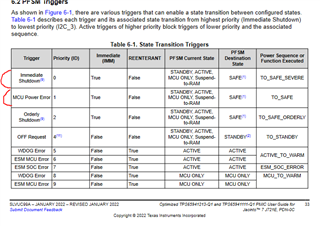Dear team,
1. We have the System Supply Voltage Monitor function as below. When VSYS_SENSE >6V, the mosfet between VSYS and VCCA will be disconnected. My customer has a question for this question. VSYS connects to pre-regulator's output, and pre-regulator's output is 3.3V, so it is impossible for its output to exceed 6V. Therefore they are wondering what fault would make VSYS exceed 6V? Could you please give us the fault condition?

2. I noticed there are two different thresholds for VCCA's UV/OV. For example, 9.5aa said that the OVP threshold is 3.9V, but in our NVM setting, VCCA_OV is 10% which means the threshold is 3.3+0.33=3.63V. I don't know which threshold is correct? It seems that 9.5aa and 9.5ab specs have no use. Could you please help analyze why we have two thresholds here and how to use them?


Thanks & Best Regards,
Sherry







